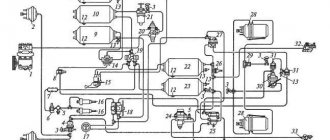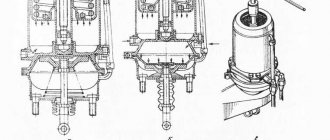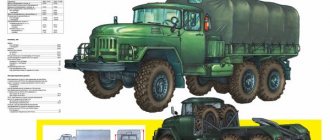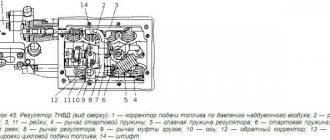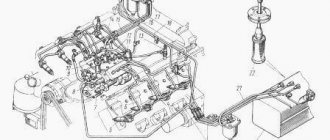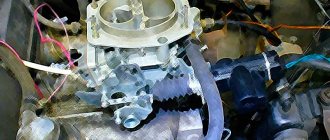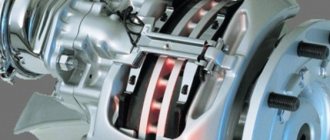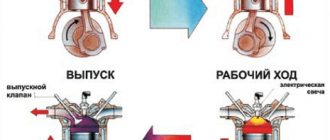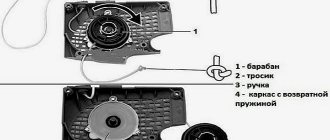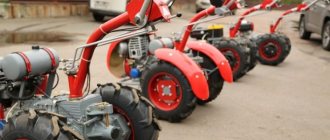One of the most overlooked devices in a car engine is the so-called “check valve”. It is also called a bypass valve or fuel pressure regulator.
How critical is it, does it need to be checked and how often does it need to be done? I must say, it is quite difficult to find a car service that would have equipment for conducting “fuel tests”. As a rule, they do it the old-fashioned way: they pinch the “return” or disconnect it and look at the thickness of the fuel stream from the hose.
The only thing that can be determined by such a “test” is that the fuel pump somehow works. It is, as you understand, impossible to measure the pressure created by the pump using old-fashioned tests. Well, perhaps only in the case when no fuel comes from the return line at all or barely drips.
What is a check valve
The check valve in the fuel system should only allow fuel to flow in one direction. This is the main purpose of OKDT. When the fuel pump is not working, the device automatically closes the return fuel line to prevent unused fuel from flowing into the tank.
When the valves are working properly, the pressure in the main pipes does not drop for a long time after the engine stops. The small part is calibrated. The design consists of several elements:
Improving the starting characteristics of the internal combustion engine is the main function of the exhaust valve. A working part installed in a certain location in the fuel line maintains the optimal value of the residual pressure.
It is not difficult to understand how a valve installed on a ramp works:
The operation of the entire fuel system of the vehicle depends on the small device. If there is no residual pressure in the line, it must be created every time the engine is started. The driver is forced to spend extra time cranking the starter.
How to find your device
There are models in which the valve is mounted in the fuel rail housing. A common installation location is the section of the fuel line located between the injectors and the tank.
There are vehicles in which the part is mounted directly into the fuel pump housing. In modern cars equipped with a fuel preheating system, the OKDT housing is located before the preheater. The installation location depends on the make of the machine:
Source
Installing additional OK
It is recommended as an option for upgrading a system in which the original valve no longer holds (or does not exist at all). You just need to try to choose a high-quality valve, and the cross-sectional dimensions must be suitable. For example, some models of VAZ valves are not suitable for foreign cars. You can install them, but they don't last long. As soon as you accelerate sharply or climb a mountain, the valve slips and the car begins to choke.
It would be better to buy OK from parsing. Find the fuel pump of a specific car model, check the valve, if it works, take it. It does not matter whether the pump itself is running or not. The main thing is to hold the valve.
Fuel system check valve Nexia
All that remains is to embed the valve into the line, in any convenient place. For example, between the fuel pump and the filter. Then check on a hill or when accelerating to see if the car is choking.
Source
Fuel system check valve: 4 main faults and how to fix them
The fuel systems of modern car engines are complex systems of mechanisms and assemblies. Among them there are systems that can only be operated by a specialist. However, simpler systems, such as those found, for example, in older VAZ car models, can be more difficult to repair than systems in modern cars. Failure of even the smallest parts of the fuel system can seriously impair the performance of the vehicle. The fuel system check valve is no exception. But, before starting any repair work, you need to find out about the structure and functions of this unit.
Checking the fuel pump of a carburetor car (mechanical)
Mechanical fuel pump - diagram
To check the functionality of the fuel pump, you need to:
- Remove the fuel line from the carburetor inlet.
- Immerse the tube in a specially prepared transparent bottle, manually operating the pumping lever, you will notice how strong and dense the stream is supplied with fuel. Air pollution should not be visible visually.
A jet being late is not a sign of a breakdown, especially if the car has been parked for a long time. Usually the main cause of failure is diaphragms eight and nine.
However, both the filter and the inlet/outlet valve need to be checked.
Even when replacing the seals, fuel leakage may occur. In this case, the problem is the tightness of the fuel pump housing due to deformation during repairs.
Let's summarize:
There are many causes for both electrical and mechanical fuel pump failures, and having to find/repair the problem can take you by surprise. By following the above recommendations, you can independently carry out all the necessary measures to diagnose this device. And you should start with the power source (if it is an injection pump) and the operation of the membrane when checking a mechanical type injection pump. Most often, unstable operation of the fuel pump is not due to its failure, but to related parts - filter, check valve or injectors.
Check valve functions
The fuel pumps of modern cars have high performance and, with proper care, provide a continuous supply of fuel, regardless of the load being generated. It is impossible for the engine to operate at idle speed without a fuel system check valve.
The main purpose of this valve is to prevent the build-up of too high pressure in the fuel system, which could result in the fuel hoses breaking. In principle, the purpose of any valve is to allow the movement of different fluids in one main direction. Located in the fuel system, this valve prevents a number of problems that can arise in the system as a result of broken hoses.
For example, if you are driving a car with a diesel engine, then a breakdown of the check valve along the way can cause the fuel system to begin to fill with air. The presence of air is also unacceptable in injection power systems (read also what an injector is).
Additionally, we recommend reading our specialist’s article on how the car’s fuel system works.
What are the features of the diesel engine power system? You can learn about this from the detailed material of our author.
We also advise you to carefully study our expert’s article, which describes in detail how the fuel level sensor works.
If the driver stops the engine, while fuel flows into the tank along the working line, then the vacated space is quickly filled with air. In such situations, you will have to turn the engine with the starter for at least fifty seconds.
Symptoms of a problem
The following characteristic signs indicate a malfunction of the fuel system:
- after idle time the engine starts unstably;
- more fuel is consumed;
- smoke comes out of the exhaust pipe during acceleration;
- During maintenance, an increased content of CH and CO was recorded.
Signs of a faulty check valve in the fuel pump:
- the motor is unstable at minimum speed;
- to start the engine, you have to rotate the starter several times while simultaneously pressing the gas pedal;
- fuel hoses are leaking, tightening the clamps does not solve the problem;
- In idle mode the speed changes sharply.
Device and principle of operation
The check valve device is simple. The entire mechanism consists of a spring, a membrane and the valve itself. The ball-type valve is equipped with a special seat, which is made of soft metal and is calibrated as accurately as possible.
The valve body is equipped with three outlets: the first is for the intake manifold, and the others are for fuel removal. Fuel moves freely through the valve in only one direction.
It is not able to flow back into the valve due to the pressure created on it, which is why it closes. The valve opens due to the movement of the spring resulting from the vacuum as the engine speed increases. Excess fuel is returned back to the fuel tank.
The check valve for diesel fuel is no different in operating principle from its “brother” used in gasoline engines; differences can only arise in the location of this unit.
Indirect acting safety valves
As the flow through the safety valve increases, it is necessary to increase the diameters of the underwater channels and the shut-off and control element. Due to an increase in the area of the sealing surface, an increase in the spring preload force will be required, and therefore an increase in the spring itself.
To ensure relatively small valve dimensions at large flow rates, indirect-acting safety valves are used, consisting of a main and control valve.
The control valve is a classic direct-acting safety valve. This valve is capable of passing only a small flow. However, when it opens, due to the resulting pressure difference across the constant throttle 6, the shut-off and control element 5 will move upward, connecting the pressure line with the drain.
Spring 4 in this valve is soft; it is designed to return the shut-off and control element to its original state.
The valve is adjusted using adjusting screw 1, which allows you to change the preload of the power spring 2.
Characteristics of indirect acting valve
The characteristics of an indirect-acting safety valve are flatter; a valve of this design has smaller dimensions than a similar direct-acting valve.
Source
Location
Where is the fuel system check valve located? You can find this parameter in the instructions, but most often this valve is attached to the fuel rail in the housing. The fuel rail is a metal structure onto which, in addition to our valve, the injectors responsible for injecting fuel into the engine are also attached.
In diesel vehicles, due to the fact that the pressure at the inlet of the injection pump (high pressure fuel pump) must remain stable, a check valve is attached between the low pressure hand pump and the injection pump. If the car has a special fuel preheating system, then a check valve is installed in front of this system.
Correct selection and replacement of the injection pump bypass valve
Reducing valves have an extremely simple design, but they are constantly subjected to high loads and quite often fail. Valve malfunction is manifested by deterioration of engine performance - it loses throttle response and in some modes there is a noticeable deterioration in its performance. In these cases, it is necessary to dismantle and check the valve, and, if it is faulty, replace it.
To replace, it is necessary to select a bypass valve of the same type and model that is installed on the injection pump by the manufacturer - only in this case there is a guarantee that the valve has the necessary characteristics and will ensure normal operation of the pump. Many valves allow adjustment of the pressure at which fuel is bypassed - this adjustment must be made in strict accordance with the instructions for maintenance and repair of the car/tractor. As a rule, adjustment comes down to changing the number of washers placed under the valve head, although there are exceptions - it all depends on the specific type of device.
With the correct selection, replacement and adjustment of the pressure reducing valve, the fuel pump will operate effectively in all modes, ensuring normal operating characteristics of the power unit.
Fuel system check valve malfunction
Symptoms of a problem
There are several characteristic signs that may indicate a malfunction of the check valve:
Due to the fact that the design of the check valve is completely mechanical, its diagnosis using special instruments is impossible. It will not be possible to disassemble the check valve and repair it, since its entire structure is quite cheap, and there are no individual spare parts on sale.
You can find out whether the valve is working properly by measuring the pressure in the fuel system with a pressure gauge. To do this, connect the pressure gauge to the section that supplies power to the engine. A rapid decrease in pressure when the engine is stopped will indicate a valve malfunction.
Another way to check the valve's functionality is to monitor the pressure level when the return hose is pinched. The pressure should increase, but this method is not suitable for all cars, since in some of them these hoses are made of metal.
Basic faults
The main malfunction of a check valve is failure due to long-term use. Any car part has its own expiration date, after which, even with proper handling, it will no longer function as before.
Causes of malfunctions
Why does the valve fail? Recently, the auto parts market has been flooded with cheap Chinese parts. Quite often such spare parts fail due to manufacturing defects. The check valve is no exception.
As mentioned above, wear and tear is often caused by time and poor quality fuel. If gasoline or diesel fuel is mixed with water, then such a mixture will be destructive for many units of the fuel system.
Valve clogging as a result of using low-quality fuel can also be a significant cause. Clogging generally leads to a decrease or cessation of the performance of many vehicle components (for example, air filters).
Once fuel is mixed with water and enters the system, moisture may enter the regulator. Often along with dirt if the filter is faulty.
We also recommend reading our expert’s article, which talks about where the fuel filter is located.
You may also be interested in our author's article on how to remove a faulty fuel pressure regulator.
What causes breakdowns
Often the check valve of the VAZ fuel system fails. The reason for this may be the use of defective or low-quality parts. Therefore, you should be careful when purchasing spare parts from unverified stores. There are also defects in factory parts of domestic budget cars.
Most often, failure occurs due to natural wear and tear during long-term use. It is mainly the spring and the diaphragm that become unusable; cases of complete valve failure are extremely rare.
Low quality fuel can also cause breakdowns. After refueling with gasoline mixed with water, moisture ends up in the regulator. Dirt may also get into it due to untimely replacement of the fuel filter.
Diagnostics and troubleshooting of check valve operation
So, you suspect that the vehicle's performance has decreased due to a malfunction of the fuel system check valve, and there are some signs of its malfunction. In order to find out whether this is so, several methods are used.
Most often, the pressure level is checked. An adequate pressure level should be about 3 kg/cm2 (for passenger cars). At the same time, the pressure level should not drop sharply when the engine is stopped. Otherwise, this will also be a sign of a faulty check valve.
As mentioned above, hose compression is sometimes used. But this method is not always suitable, since only a rubber elastic hose can be compressed.
So, as a result of measuring the pressure with a pressure gauge inserted into the rail, you concluded that after stopping the engine it began to drop significantly. In this case, either there is a defect in the fuel line, or the valve itself is faulty. If the result at the outlet of the fuel pump is different, then the valve is faulty.
To fix the problem, select a high-quality check valve from a spare parts store that fits the cross-sectional dimensions. If you select a valve with the wrong cross-sectional dimensions, it may begin to “slip.” Before purchasing, check the operation of the valve on site, if possible. The check valve must be cut into the line at any suitable location.
For example, this can be done between the fuel pump and the filter. After this, test the functionality of your car by driving it up a hill at an angle. If the car shows no signs of loss of power, then the valve has failed.
There is also a folk method for troubleshooting, but it is only suitable if the valve is clogged. You need to hit the valve a couple of times with a hammer. The impact force must be calculated to avoid mechanical damage. With this effect, foreign bodies trapped in the valve can be crushed or even fly out of the valve. But most often it is much easier to replace the valve with a new one.
Checking the serviceability of the fuel pump on the injector
When you hear a slight hum or a slight hum when you turn the ignition key, this means that the fuel pump is working, pumping gasoline creates pressure in the system. If, when trying to start, there are no such signs of fuel injection pump operation, then we can assume a malfunction of the electrical system, the pump itself or its individual parts. Therefore, let’s look at how you can check the operation of a gas pump using a phased logic chain. From whether the BN is getting power to whether the fuel pump is pumping and if so, how much pressure is being built up at the fuel rail.
Step 1: Checking the fuse
Checking the fuel pump fuse includes checking the integrity of the conductive plate and, if it breaks, replacing it. But if you don't have a new fuse, wrap copper wire around the fuse contacts. If it burns out again, it means the problem may be in the wiring.
Stage 2: Checking the relay
To check the fuel pump relay, remove it from its socket and connect a 12-volt light bulb according to the diagram. If the light is on, then the relay itself is also working properly. Alternatively, you can use a multimeter in ohmmeter mode to measure the resistance of the relay coil winding. One sensor is connected to terminal 85 and the other to 86. The device will indicate an open circuit if the relay is not working.
Make sure that the terminals do not oxidize - this will negatively affect the power supply to the fuel pump motor!
Stage 3. Checking the power supply to the BN
Checking the fuel pump voltage is done using a multimeter. The meter probes in voltmeter mode (0-20 volts) must be connected to the fuel pump power terminals. Turn on the ignition and take readings on the device. 12-12.5 volts is normal operating voltage. If there is voltage, but the pump does not work, check the electric motor.
Stage 4. Checking the fuel pump motor
To prevent failure of the electric motor, we supply 12 volts directly from the battery to the fuel pump terminals. It works: we check its functionality, check the valve, measure the pressure with a pressure gauge. If it doesn’t work, check the coil for a break.
Does the fuel pump not work when voltage is applied to the terminals? We check the stator winding: take a tester (multimeter) and switch it to ohmmeter mode, it should show resistance, otherwise there is a problem with the winding and it needs to be replaced. With resistance readings, the problem may be that the winding is shorted to the fuel pump housing. The tester probe goes to the positive terminal, the second one goes to the body. If it is short, there will be no interruptions.
Step 5. Checking the coarse filter
By disassembling the coarse filter (see Technical documentation for the car) from the fuel pump, you can even visually determine how dirty it is. If there is a large amount of deposits, it is recommended to replace the filter; if the problem occurs on the road, clean it with a brush and gasoline.
Step 6: Check the check valve
The check valve must constantly prevent fluid from flowing in the opposite direction. During operation, its performance decreases, which reduces technical characteristics.
1 way. Checking the check valve involves measuring the pressure with a pressure gauge. It is necessary to connect it to that part of the system that is directly involved in supplying fuel to the internal combustion engine. Pressure readings should not exceed 3 kg/m2 cm. (Relevant for cars). And when the engine is stopped, the pressure should not drop sharply.
Check and clean check valve
method 2. To check the operation of the fuel pump check valve without a pressure gauge, you need to clamp the return line and observe the operation of the engine. If the check valve fails, the internal combustion engine will operate at higher speeds (in the absence of other problems).
method 3. Combine diagnosis and cleaning of the check valve at the same time. Remove and inspect - the unit requiring cleaning is visible to the naked eye. You can also blow out the valve with a dense stream of air, but it is better to pass water under pressure through it. This will combine valve control with valve cleaning. If the valve does not work even after this, it must be replaced.
Step 7. Pressure check
In order for the diagnostics to correctly identify the pressure gauges, it is necessary to reset the initial fuel pressure by turning off the fuel pump fuse.
Check with a pressure gauge how to pump up the fuel pump
How to check a fuel pump with a pressure gauge
You can check the fuel pump with a service pressure gauge as follows: connect the device to the fuel rail. Conclusion: through the edge of the hood to the windshield, where we securely install the device.
We record measures in:
Static position. Turn the ignition key and observe the pressure gauge readings; they should not exceed 3.7 atm.
Dynamics. We turn on third gear (speed about 50 km/h), observing the pressure gauge readings. While driving, if the problem is pressure, the reading will be below 3 atm or above 3.7 atm.
Low fuel system pressure may be due to a fuel leak. The fuel channel will show a pressure drop of less than 1.6 atm. Fault location: fuel injector or regulator.
It is worth noting that despite all the similarities (principle of operation, purpose), the diagnostic methods for a mechanical fuel pump differ and we will consider this in more detail below.
conclusions
The fuel system check valve is an important component of this system, the failure of which can cause a lot of problems for the driver. This will be especially painful during movement. Therefore, it is worth using only high-quality fuel, and at the slightest sign of a malfunction, which were listed above, diagnosing the fuel system.
After all, the problem may lie not only in the valve, but also in other small parts. Diagnostics at a service station almost always reveals such faults, so do not forget about timely maintenance of the car, even if everything seems to be in good order. Good luck and easy travels!
Source
Direct acting safety valves
In direct-acting valves, the shut-off and control valve is acted on one side by a spring force, and on the opposite side by a fluid pressure force.
The spring in such valves is called power, because. It is precisely this that exerts the force that holds the shut-off and control valve until it opens.
The seat type safety valve discussed earlier is an example of a direct acting valve. The same type includes spool-type valves.
In the initial state, spool 3, installed in housing 1, closes the channels in the pressure and drain lines. When the pressure force increases to a value exceeding the force of spring 2, the spool will move upward, opening a channel for the passage of flow from the pressure line to the drain line.
Characteristics of direct acting valve
The characteristic of the direct acting safety valve has a fairly large lift.
Direct-acting valves are prone to self-oscillation. At high flow rates and high pressures, the spring dimensions must be very large.
Damping device
The operation of the safety valve is affected not only by static but also by dynamic loads.
To reduce the negative impact of self-oscillations of a spring-loaded shut-off and control element, damping devices are used in direct-acting safety valves.
The most common damping device is a damping piston , which is rigidly connected to the shut-off and control element.
For damping, a narrow channel can be made in the piston or a flat can be removed, as in the example shown in the figure.
During the movement of the piston, the liquid moves in a small gap. In this case, a damping force appears directed in the direction opposite to the movement of the piston.
Most modern direct acting hydraulic relief valves are designed with a damping piston.
How to install a check valve in the fuel system
The fuel systems of modern car engines are complex systems of mechanisms and assemblies. Among them there are systems that can only be operated by a specialist. However, simpler systems, such as those found, for example, in older VAZ car models, can be more difficult to repair than systems in modern cars. Failure of even the smallest parts of the fuel system can seriously impair the performance of the vehicle. The fuel system check valve is no exception. But, before starting any repair work, you need to find out about the structure and functions of this unit.
Problems
Why does OK fail? This happens quite often, since the market today has become more defective as a percentage. Chinese counterfeits at low and medium prices attract the attention of motorists who do not suspect a trick. It is worth installing such a part, and after a while problems arise.
How to check the fuel system check valve
If the part is of high quality, then the malfunction occurs for a natural reason - due to wear. As a rule, either the spring or the membrane deteriorates. It is extremely rare for the valve to fail completely, which is a credit to it.
Another common cause of failure that we have seen lately is low quality fuel. Gasoline or diesel fuel mixed with water is harmful to many parts of the fuel system.
Typical symptoms of an OK malfunction look like this:
- the speed changes unexpectedly in idle mode;
- the engine starts only after pressing the gas pedal, although previously it started only by twisting the starter;
- at low speeds the engine operates extremely unstable;
- Liquid leaks from the supply and return fuel pipes, although the sealing of the hoses is beyond doubt.
Where is the fuel check valve located?
Let's find out where the fuel system valve of various cars is located. On diesel power plants, the mechanical structure is hidden between the fuel injection pump and the low-pressure pump. This arrangement of the product allows you to create a stable pressure at the outlet of the high-pressure pump.
The system has proven itself well:
In diesel installations where a pre-start heating system is provided, the fuel check valve is located in front of the heating system. A typical example is the same KamAZ or Magirus trucks operating in the Far North.
On domestic passenger cars, such as the VAZ 2110 and 2114 with sixteen valves, the mechanical structure is located in the gasoline pump and on the fuel frame. This is analogous to installing a diesel engine.
Today, old carburetor cars with rear-wheel drive still run on our roads: eights and nines (VAZ 2108 and VAZ 2109). On them, the role of the return device is assigned directly to the gasoline pump.
It stands on the cylinder block and prevents the passage of fuel in the opposite direction: into the fuel tank.
The fuel supply system of automobile gasoline and diesel power units is a technically complex device that should not be approached without knowledge. And even more so, try to carry out technical treatment on your own.
The check valve plays an important role in the regular supply of fuel. Let's focus our attention on its design and installation in the car. Let's look at the problems and characteristic signs of a malfunction. We will also decide on ways to check it.
Technical requirements for safety valves
The main requirement for emergency valves is reliability and precision of operation. This is achieved through:
- Quick opening when the trigger threshold is reached.
- Sufficient opening capacity.
- Clear closure when the pressure drops to an acceptable level.
- Guaranteed tightness and no leaks at normal pressure before and after actuation.
- Reliability during the specified service life and the designed number of operations. Stability of parameters of elastic elements and quality of surfaces of the spool and seat.
All safety valves must be periodically tested for operability, integrity and quality of seals. To do this, it is dismantled and sent to a certified calibration laboratory or testing center. For fuses operating in complex continuous cycle installations, on-site testing is permitted. It is carried out using the test-in-action method.
Malfunction of the Fuel Pressure Regulator. 4 Signs | Causes, Checking and Cleaning
Malfunctions of the fuel pressure regulator lead to the fact that the engine starts with difficulty, has a “floating” idle speed, the car loses dynamic characteristics, and sometimes fuel leaks from the fuel hoses.
As a rule, a fuel pressure regulator (abbreviated as RTD) is installed on the fuel rail and is a vacuum valve. In some car models, the RTD cuts into the fuel return hose of the fuel system.
To determine that the fuel system malfunction lies in a faulty pressure regulator, it is necessary to carry out a series of simple checks.
Where is the fuel pressure regulator located?
To find the installation location of the fuel pressure regulator, let’s figure out what it is and what it is needed for. This will help in further searches and diagnostics.
The first thing you need to know is that there are two main types of RDTs - mechanical (old type) and electrical (new type). In the first case, this is a vacuum valve, the task of which is to transfer excess fuel under excessive pressure back into the fuel tank through the corresponding hose. In the second, it is a fuel pressure sensor that transmits relevant information to the ECU.
Typically, the fuel pressure regulator is located directly on the fuel rail. Another option for its placement is the fuel return hose of the power system. Another option is to locate the regulator directly in the fuel tank on the pump module. In such systems there is no fuel return hose as unnecessary. Such an implementation has several advantages, including simplified design (no extra pipeline), excess fuel does not enter the engine compartment, fuel heats up less and does not evaporate as much.
How does the fuel pressure regulator work?
Structurally, the old-style valve (installed on gasoline cars) has its own body, inside which there is a valve, a membrane and a spring. The housing has three fuel outlets. Through two of them, gasoline passes through the pressure regulator, and the third outlet is directly connected to the intake manifold. At low (including idle) engine speeds, the fuel pressure in the system is low and it all goes into the engine.
As the speed increases, the corresponding pressure increases in the manifold, that is, at the third terminal of the RTD, a vacuum (vacuum) is created, which, at a certain value, overcomes the resistance force of its spring. This creates the movement of the membrane and the opening of the valve. Accordingly, excess diesel fuel gets access to the second output of the regulator and goes back into the fuel tank through the return hose.
Due to the described algorithm, the fuel pressure regulator is often called a check valve.
As for the fuel pressure sensor, it is a little more complicated. So, it consists of two parts - mechanical and electrical. The first part is a metal membrane that bends under the influence of force caused by pressure in the fuel system. The thickness of the membrane depends on the pressure for which the fuel system is designed.
The electrical part of the sensor consists of four strain gauges connected according to a “Winston bridge” circuit. Voltage is applied to them, and the more the membrane bends, the greater the output voltage from them will be. And this signal is sent to the ECU.
As a result, the electronic control unit sends the appropriate command to the pump so that it supplies only the amount of fuel required at the moment.
Diesel engines have a slightly different fuel pressure regulator design. In particular, they consist of a solenoid (coil) and a rod, which rests against the ball to shut off the reverse flow. This was done for the reason that the diesel engine vibrates very strongly during its operation, which affects the wear of the classic (gasoline) fuel regulator, that is, partial and even complete compensation of hydraulic vibrations occurs. However, its installation location is similar - in the engine fuel rail. Another option is on the fuel pump housing.
Signs of a malfunctioning fuel pressure regulator
There are five main symptoms of a malfunctioning fuel pressure regulator (both types), which can be used to judge the complete or partial failure of this important unit. Moreover, the symptoms indicated below are typical for cars with both gasoline and diesel engines.
However, it is worth mentioning that the listed situations may be signs of failure of other engine components (fuel pump, clogged fuel filter), so it is advisable to carry out comprehensive diagnostics in order to accurately determine its performance.
So, the signs of a malfunctioning fuel pressure regulator are as follows:
Accordingly, if at least one of the above symptoms appears, it is necessary to perform additional diagnostics, including using an electronic error scanner available in the ECU memory.
Fuel pressure regulator error
In modern cars, a fuel pressure sensor is installed as a regulator. If it fails partially or completely, one or more errors associated with this unit are formed in the memory of the electronic engine control unit. At the same time, the engine malfunction light is activated on the dashboard.
When there is a DRT malfunction, the driver most often encounters errors numbered p2293 and p0089. The first is called “fuel pressure regulator - mechanical failure”. The second is “the fuel pressure regulator is faulty.”
For some car owners, when the corresponding regulator fails, errors are formed in the ECU memory: p0087 “the pressure measured in the fuel rail is too low relative to the required one” or p0191 “fuel pressure regulator or pressure sensor.”
The external signs of these errors are the same as the general signs of failure of the fuel pressure regulator.
Checking the fuel pressure regulator
Testing the functionality of the fuel pressure regulator will depend on whether it is mechanical or electrical. the old regulator of a gasoline engine . You need to act according to the following algorithm:
FakeHeader
Comments 66
Pump replacement. The pump has its own valve.
the valve should fall apart from the inside about the quality of the parts. There are valves in the fuel pump that are supposed to keep you on track. your pump is probably already pumping poorly or you need to change the fuel injection pump or the valve inside (repair kit and, again, it’s not a fact that the quality will be). I replaced the diaphragm in mine, but did not change the valve, although on the Internet they do not hold up well, many people complain about the repair.
in general, you have the following options: 1 make an attachment for manual pumping and manual pumping (the same rope) from waste 2 valve replacements (high-quality) up to 500 rubles 3. Replacement of the injection pump (again high-quality) 1000-2000 rubles 4 switch to electro. 5 is not a standard version in the form of a check valve (high quality).
in option 5, you need to find a specific check valve for the gas line; you should also take into account that the pressure in the gas line is low.
In addition to the electric pump. The trick is that it doesn't require valves. Even though all the fuel in the carburetor had evaporated, I turned on the ignition, waited a couple of three seconds while the EBN primed the carburetor and started.
1200 rubles for a photo report
We pay for photo reports on car repairs. Earnings from 10,000 rubles. / Month Write:
The reasons why fuel pumps fail are not always the same, and the devices themselves can be electrical or mechanical. Diagnostics of the performance of these types is different, so we will consider ways to separately check the operation of fuel pumps. However, the operation of the fuel pump can be checked in 7 steps.
The need to check the fuel injection pump appears when the following signs of malfunction occur:
- the engine stopped;
- the car moves chaotically, jerkily;
- the engine idles unstable and does not start;
- there are “floating” turns;
- increased noise, whistling when the car is moving.
Reference
Many people know that the fuel system valve aggregates:
There is nothing complicated about the mechanical design. This is a ball-type device with a seat, which is made of soft metal, with the most accurate balancing. Fuel flows freely through the fuel valve in one direction. The pressure that is created prevents gasoline or diesel fuel from flowing back into the fuel tank, since the non-demountable structure is locked.
Despite its simplicity, the device can cause a lot of trouble for a novice and an experienced driver. Therefore, it is necessary to know its possible vagaries and ways to eliminate breakdowns. But first of all, understand where the mechanical structure is installed.
“The concept of a fuel system check valve should not be confused with a pressure reducing device.”
Design
Any check valve (OC) is nothing more than an element that ensures the movement of fuel in one direction. It can block the flow of unused fuel back into the fuel tank.
Its design, as a rule, implies the presence of a calibrated saddle made of soft metal. The valve allows gasoline or diesel fuel to pass in one direction, but when the engine stops, the valve automatically closes and the movement of liquid stops.
Fuel system valve and pipe
Despite the simplicity of the design of the bypass valve, its malfunction or its banal absence in the system can lead to great difficulties. For example, the normal functioning of the motor is impossible, and starting it becomes more difficult.
There is no need to confuse the OK with a pressure reducing valve. The latter is responsible for pressure stability, although it operates in conjunction with a check valve.
Read more about pressure reducing valve. It is responsible for equalizing the pressure in the section of the fuel rail where the fuel liquid enters the injectors. If it were not for this valve, the injectors would receive fuel under different pressures or without it, as a result of which they would not be able to transfer gasoline further into the chamber.
Pressure reducing valve or pressure regulator
The regulator stops supplying fuel to the injectors when the engine stops and the ignition is turned off. The shut-off mechanism simply operates, cutting off part of the fuel line. Gasoline remains only in the area between the fuel pump and the ramp, if OK. If not, there will be no fuel in the system; it will leak back into the tank.
Types of valves
Modern injection pumps use several valves. One of the main ones is injection. Let's consider its functions and tasks.
It is customary to distinguish discharge valves by type: cylindrical, combined, mushroom, etc.
| Mushroom discharge valve | |
| Most widespread | Diesel systems |
| Valve with suction belt | It is pressed against the socket by a spring and its lifting depends on the limiter |
| Operating principle | During the injection process, fuel presses from below on the valve mushroom, as a result of which it rises and opens access to the injector. When the supply stops, the spring lowers the valve down and then presses it tightly against the seat. When the suction belt enters the guide, the volume of the discharge line increases and the pressure in the system decreases. |
| Cylindrical valves | |
| Form | Cup |
| Weight | The mass of cylindrical valves is less than that of mushroom valves. They allow for a noticeable reduction in the volume of the fitting. |
| Plate valves | |
| Device | They are simple in design, have low mass, and therefore have low inertia. |
| Operating principle | As the pressure increases, both plates rise. When the lower plate rests against the protrusion of the nut, the upper one continues to move upward and allows fuel to access the fitting. |
| Combination valves | |
| Purpose | Combination valves are used to eliminate vibrations in the fuel injection line. |
| Operating principle | The valve consists of two plasti, one of which is loaded with a spring. During the pumping process, plate 1 moves upward and rests against the body with its protrusions. Fuel passes through the hole in the bottom plate, flows around the top plate and enters the fuel injection line. After the fuel pressure is cut off, the upper plate is pressed against the lower plate, decoupling the fuel line and the high-pressure pump. |
| Double valves | |
| Scope of application | Double valves are installed in critical heavy diesel engines. |
| Purpose | The presence of two sequentially located valves ensures greater reliability of the fuel system, as it creates greater tightness of the unit. In addition, if one of them fails due to jamming or solid contaminants getting under the cone, the other continues to independently perform the functions of isolating the pipeline and the pump. |
Direct acting safety valves
In direct-acting valves, the shut-off and control element is acted on by a spring force on one side, and by the fluid pressure force on the opposite side.
The spring in such valves is called power, because. It is this that exerts the force that holds the shut-off and control element until it opens.
The seat type safety valve discussed earlier is an example of a direct acting valve. The same type includes spool-type valves.
In the initial state, spool 3, installed in housing 1, closes the channels in the pressure and drain lines. When the pressure force increases to a value exceeding the force of spring 2, the spool will move upward, opening a channel for the passage of flow from the pressure line to the drain line.
Characteristics of direct acting valve
The characteristic of the direct acting safety valve has a fairly large lift.
Direct acting valves are prone to self-oscillation. At high flow rates and high pressures, the spring dimensions must be very large.
Damping device
The operation of the safety valve is affected not only by static but also by dynamic loads.
To reduce the negative impact of self-oscillations of a spring-loaded shut-off and control element, damping devices are used in direct-acting safety valves.
The most common damping device is a damping piston , which is rigidly connected to the shut-off and control element.
For damping, a narrow channel can be made in the piston or a flat can be removed, as in the example shown in the figure.
During the movement of the piston, the liquid moves in a small gap. In this case, a damping force appears directed in the direction opposite to the movement of the piston.
Most modern direct acting hydraulic relief valves are designed with a damping piston.
How can you check a check valve?
You can find out what condition the fuel valve is in as follows.
You can find out how the device works by pinching the “return” fuel hoses. If the permanent mechanical structure is in order, the pressure should increase.
This method is only for cars that have rubber hoses installed.
Self-diagnosis can be carried out without using a pressure gauge. This concerns the problem of unstable operation of the internal combustion engine (ICE) and poor acceleration. Having pinched the rubber hose that moves the fuel in the opposite direction, you need to pay attention to the operation of the engine. If the speed increases and the engine cylinders operate as planned, then the check valve is faulty.
Other diagnostic methods
You can also check the fuel system check valve by monitoring the pressure level when the return hose is pinched, in which case it should increase. Unfortunately, this method is not suitable for all cars, since many of them have short hoses or are completely replaced with metal ones.
If the engine picks up speed poorly and starts to stall, you can check it without a pressure gauge. To do this, you also need to clamp the return hose and observe the operation of the engine. If at this moment the required power is gained and all cylinders are functioning, it is necessary to replace the fuel system check valve.
Main features of check valves
A device such as a check valve is small in size, but is quite powerful and ensures a constant direction of water flow in the pipes. Similar valves are installed in both main and in-house water supply systems. Without a check valve at the end of the suction pipe, water will simply flow back if the centrifugal pump stops. As a result, air pockets will form in the pipeline, which will cause electrical equipment to burn out.
Depending on the installation location, there are bottom and pipeline valves. The former serve to maintain the force and direction of flow in the event of pumping equipment failure. Pipeline models, including axial and flap models, are necessary to prevent pressure drop in the system. Thus, check valves ensure efficient and reliable operation of the pumping station and protect the water supply system, pump and plumbing from water hammer.
Indirect acting safety valves
As the flow through the safety valve increases, it is necessary to increase the diameters of the underwater channels and the shut-off and control element. Due to an increase in the area of the sealing surface, an increase in the spring preload force will be required, and therefore an increase in the spring itself.
To ensure relatively small valve dimensions at large flow rates, indirect-acting safety valves are used, consisting of a main and control valve.
The control valve is a classic direct-acting safety valve. This valve is capable of passing only a small flow. However, when it opens, due to the resulting pressure difference across the constant throttle 6, the shut-off and control element 5 will move upward, connecting the pressure line with the drain.
Spring 4 in this valve is soft; it is designed to return the shut-off and control element to its original state.
The valve is adjusted using adjusting screw 1, which allows you to change the preload of the power spring 2.
Characteristics of indirect acting valve
The characteristics of an indirect-acting safety valve are flatter; a valve of this design has smaller dimensions than a similar direct-acting valve.
Which way to go
There are two options for eliminating the problem. Take the car to a service station and wait for the repairs to be completed. In this case, you need to shell out a certain amount of money, it’s a pity.
Having knowledge and understanding of the car’s structure, you can carry out repairs yourself. Saving money in person. However, there is a possibility of stepping on a pitfall. Can't deal with the problem.
Then you will have to shell out additional money for repairs in a specialized center, how do you like this prospect? In any case, the decision is yours to make.
Experts recommend not to reinvent the wheel, but to give the car to professionals who will replace it quickly, with a guarantee of quality.
Decide what is more important to you: savings or stable operation of the power unit, good luck to everyone!
Selection of emergency valves
When designing a water supply, heating system or process installation, it is necessary to clearly define the maximum pressure values permissible for its components or network sections. This takes into account such parameters as:
- boiler or main pump performance;
- volume and operating temperature of the working environment;
- features of its circulation.
Based on this, the type, cross-section, capacity, threshold response value, response speed and time to return to its original state, as well as the number and installation locations of safety valves are determined.
In domestic heating systems, spring valves are most often used. For liquid media, low or medium lift devices are sufficient. The throughput should provide a quick pressure release to acceptable values.
The design of the housing is determined by the location where the excess amount of working fluid is discharged. If it will be discharged directly into the environment, an open type valve is sufficient. If the discharge must occur into the drain, a housing with an outlet pipe of the appropriate type of connection will be required. Most often they use threaded or nipple.
